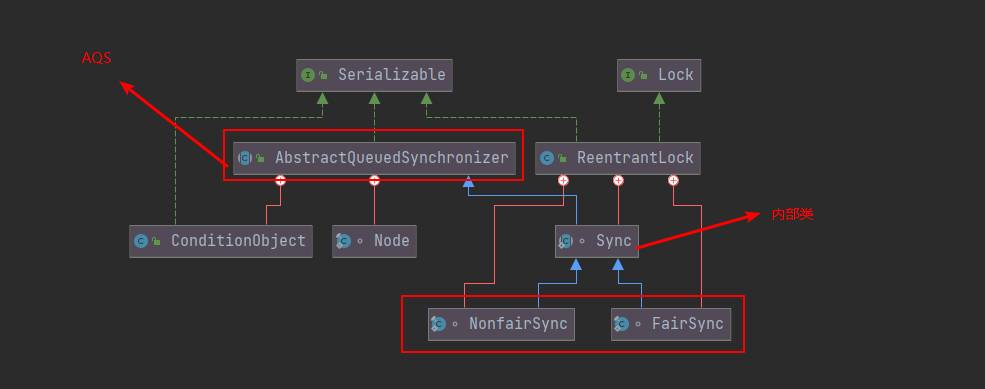系列传送门:
- Java并发包源码学习系列:AbstractQueuedSynchronizer
- Java并发包源码学习系列:CLH同步队列及同步资源获取与释放
- Java并发包源码学习系列:AQS共享式与独占式获取与释放资源的区别
基本用法介绍
ReentrantLock位于java.util.concurrent(J.U.C)包下,是Lock接口的实现类。基本用法与synchronized相似,都具备可重入互斥的特性,但拥有更强大的且灵活的锁机制。本篇主要从源码角度解析ReentrantLock,一些基本的概念以及Lock接口可以戳这篇:Java并发读书笔记:Lock与ReentrantLock
ReentrantLock推荐用法如下:
class X {
//定义锁对象
private final ReentrantLock lock = new ReentrantLock();
// ...
//定义需要保证线程安全的方法
public void m() {
//加锁
lock.lock();
try{
// 保证线程安全的代码
}
// 使用finally块保证释放锁
finally {
lock.unlock()
}
}
}
继承体系

- 实现Lock接口,提供了锁的关键方法,如lock、unlock、tryLock等等,以及newCondition给lock关联条件对象的方法。
- 内部维护了一个Sync,它继承AQS,实现AQS提供的独占式的获取与释放同步资源的方法,提供了可重入的具体实现。
- Sync有两个实现类,是公平锁和非公平锁的两种实现,FairSync与NonfairSync。
独占锁表示:同时只能有一个线程可以获取该锁,其他获取该锁的线程会被阻塞而被放入该所的AQS阻塞队列里面。这部分可以查看:Java并发包源码学习系列:AQS共享式与独占式获取与释放资源的区别
构造方法
Sync直接继承自AQS,NonfairSync和FairSync继承了Sync,实现了获取锁的公平与非公平策略。
ReentrantLock中的操作都是委托给Sync对象来实际操作的。
/** Synchronizer providing all implementation mechanics */
private final Sync sync;
默认是使用非公平锁:NonfairSync,可以传入参数来指定是否使用公平锁。
// 默认使用的是 非公平的策略
public ReentrantLock() {
sync = new NonfairSync();
}
// 通过fair参数指定 策略
public ReentrantLock(boolean fair) {
sync = fair ? new FairSync() : new NonfairSync();
}
state状态表示
在ReentrantLock中,AQS的state状态值表示线程获取该锁的可重入次数,在默认情况下:
- state值为0时表示当前锁没有被任何线程持有。
- 当第一个线程第一次获取该锁时会尝试使用CAS设置state的值为1,如果CAS成功则当前线程获取了该锁,然后记录该锁的持有者为当前线程。
- 在该线程没有释放锁的情况下第二次获取该锁后,状态值设置为2,为可重入次数。
- 在该线程释放锁时,会尝试使用CAS让state值减1,如果减1后状态值为0,则当前线程释放该锁。
获取锁
void lock()方法
ReentrantLock的lock()方法委托给了sync类,根据创建sync的具体实现决定具体的逻辑:
NonfairSync
/**
* Performs lock. Try immediate barge, backing up to normal
* acquire on failure.
*/
final void lock() {
// CAS 设置获取state值
if (compareAndSetState(0, 1))
// 将当前线程设置为锁的持有者
setExclusiveOwnerThread(Thread.currentThread());
else
// 设置失败, 调用AQS的acquire方法
acquire(1);
}
state值的初始状态为0,也就是说,第一个线程的CAS操作会成功将0设置为1,表示当前线程获取到了锁,然后通过setExclusiveOwnerThread方法将当前线程设置为锁的持有者。
如果这时,其他线程也试图获取该锁,则CAS失败,走到acquire的逻辑。
// AQS#acquire
public final void acquire(int arg) {
// 调用ReentrantLock重写的tryAcquire方法
if (!tryAcquire(arg) &&
// tryAcquire方法返回false,则把当前线程放入AQS阻塞队列中
acquireQueued(addWaiter(Node.EXCLUSIVE), arg))
selfInterrupt();
}
欸,这个时候我们应该就有感觉了,我们之前在分析AQS的核心方法的时候说到过,AQS是基于模板模式设计的,下面的tryAcquire方法就是留给子类实现的,而NonfairSync中是这样实现的:
//NonfairSync#tryAcquire
protected final boolean tryAcquire(int acquires) {
// 调用
return nonfairTryAcquire(acquires);
}
final boolean nonfairTryAcquire(int acquires) {
final Thread current = Thread.currentThread();
// 获取当前状态值
int c = getState();
// 如果当前状态值为0,如果为0表示当前锁空闲
if (c == 0) {
if (compareAndSetState(0, acquires)) {
setExclusiveOwnerThread(current);
return true;
}
}
// 看看当前的线程是不是锁的持有者
else if (current == getExclusiveOwnerThread()) {
// 如果是的话 将状态设置为 c + acquires
int nextc = c + acquires;
if (nextc < 0) // overflow
throw new Error("Maximum lock count exceeded");
setState(nextc);
return true;
}
return false;
}
还是很好理解的哈,先看看锁的状态值是啥?
- 如果是0,就CAS尝试获取锁,将状态从0变到1,并且设置锁的持有者为当前线程,和之前的逻辑一样啦。
- 如果不是0,表示已经被某个线程持有啦,看看持有锁的人是谁呢?如果是自己,那么好办,重入呗,将state变为nextc【原先state + 传入的acquires】,返回true。这里要注意:nextc<0表示可重入次数溢出。
- 锁已经被别人霸占了,那就返回false咯,等待后续
acquireQueued(addWaiter(Node.EXCLUSIVE), arg))方法,被置入AQS阻塞队列中。
这里非公平体现在获取锁的时候,没有查看当前AQS队列中是否有比自己更早请求该锁的线程存在,而是采取了抢夺策略。
FairSync
公平锁的tryAcquire实现如下:
//FairSync#tryAcquire
protected final boolean tryAcquire(int acquires) {
final Thread current = Thread.currentThread();
int c = getState();
if (c == 0) {
// 状态值为0的时候,我去看看队列里面在我之前有没有线程在等
if (!hasQueuedPredecessors() &&
compareAndSetState(0, acquires)) {
setExclusiveOwnerThread(current);
return true;
}
}
// 当前锁已经被当前线程持有
else if (current == getExclusiveOwnerThread()) {
int nextc = c + acquires;
if (nextc < 0)
throw new Error("Maximum lock count exceeded");
setState(nextc);
return true;
}
return false;
}
对比一下两种策略,不必说,hasQueuedPredecessors方法一定是实现公平性的核心,我们来瞅瞅:
// 如果当前线程有前驱节点就返回true。
public final boolean hasQueuedPredecessors() {
// The correctness of this depends on head being initialized
// before tail and on head.next being accurate if the current
// thread is first in queue.
Node t = tail; // Read fields in reverse initialization order
Node h = head;
Node s;
return h != t &&
((s = h.next) == null || s.thread != Thread.currentThread());
}
该方法:如果当前线程有前驱节点就返回true,那么我们想,不是前驱节点的情况有哪些呢?
- 队列为空
- 队列不为空,但当前线程节点是AQS的第一个节点。
知道这些之后,我们就明白最后那串表达式是什么意思了:队列里面的第一个元素不是当前线程,返回true,说明在你之前还有人排着队呢,你先别抢,先到先得。
公平与非公平策略的差异
我们稍微总结一下:
Reentrant类的构造函数接受一个可选的公平性参数fair。这时候就出现两种选择:
- 公平的(fair == true):保证等待时间最长的线程优先获取锁,其实就是先入队的先得锁,即FIFO。
- 非公平的(fair == false):此锁不保证任何特定的访问顺序。
公平锁往往体现出的总体吞吐量比非公平锁要低,也就是更慢,因为每次都需要看看队列里面有没有在排队的嘛。锁的公平性并不保证线程调度的公平性,但公平锁能够减少"饥饿"发生的概率。
需要注意的是:不定时的tryLock()方法不支持公平性设置。如果锁可用,即使其他线程等待时间比它长,它也会成功获得锁。
void lockInterruptibly()
该方法与lock方法类似,不同点在于,它能对中断进行相应:当前线程在调用该方法时,如果其他线程调用了当前线程的interrupt()方法,当前线程会抛出InterruptedException异常,然后返回。
// ReentrantLock#lockInterruptibly
public void lockInterruptibly() throws InterruptedException {
sync.acquireInterruptibly(1);
}
// AQS#acquireInterruptibly
public final void acquireInterruptibly(int arg)
throws InterruptedException {
// 如果当前线程被中断,则直接抛出异常
if (Thread.interrupted())
throw new InterruptedException();
// 尝试获取资源
if (!tryAcquire(arg))
// 调用AQS可被中断的方法
doAcquireInterruptibly(arg);
}
boolean tryLock()方法
尝试获取锁,如果当前该锁没有被其他线程持有,则当前线程获取该锁并返回true,否则返回false。
大致逻辑和非公平锁lock方法类似,但该方法会直接返回获取锁的结果,无论true或者false,它不会阻塞。
// ReentrantLock# tryLock
public boolean tryLock() {
return sync.nonfairTryAcquire(1);
}
abstract static class Sync extends AbstractQueuedSynchronizer {
// Sync#nonfairTryAcquire
final boolean nonfairTryAcquire(int acquires) {
final Thread current = Thread.currentThread();
int c = getState();
if (c == 0) {
if (compareAndSetState(0, acquires)) {
setExclusiveOwnerThread(current);
return true;
}
}
else if (current == getExclusiveOwnerThread()) {
int nextc = c + acquires;
if (nextc < 0) // overflow
throw new Error("Maximum lock count exceeded");
setState(nextc);
return true;
}
return false;
}
}
tryLock()实现方法,在实现时,希望能快速的获得是否能够获得到锁,因此即使在设置为fair = true( 使用公平锁 ),依然调用Sync#nonfairTryAcquire(int acquires)方法。- 如果真的希望
tryLock()还是按照是否公平锁的方式来,可以调用#tryLock(0, TimeUnit)方法来实现。
boolean tryLock(long timeout, TimeUnit unit)
// ReentrantLock# tryLock
public boolean tryLock(long timeout, TimeUnit unit)
throws InterruptedException {
return sync.tryAcquireNanos(1, unit.toNanos(timeout));
}
// AQS#tryAcquireNanos
public final boolean tryAcquireNanos(int arg, long nanosTimeout)
throws InterruptedException {
if (Thread.interrupted())
throw new InterruptedException();
return tryAcquire(arg) ||
doAcquireNanos(arg, nanosTimeout);
}
尝试获取锁,如果获取失败会将当前线程挂起指定时间,时间到了之后当前线程被激活,如果还是没有获取到锁,就返回false。
另外,该方法会对中断进行的响应,如果其他线程调用了当前线程的interrupt()方法,响应中断,抛出异常。
释放锁
void unlock()方法
// ReentrantLock#unlock
public void unlock() {
sync.release(1);
}
//AQS# release
public final boolean release(int arg) {
// 子类实现tryRelease
if (tryRelease(arg)) {
Node h = head;
if (h != null && h.waitStatus != 0)
unparkSuccessor(h);
return true;
}
return false;
}
abstract static class Sync extends AbstractQueuedSynchronizer {
// Sync#tryRelease
protected final boolean tryRelease(int releases) {
// 计算解锁后的次数,默认减1
int c = getState() - releases;
// 如果想要解锁的人不是当前的锁持有者,直接抛异常
if (Thread.currentThread() != getExclusiveOwnerThread())
throw new IllegalMonitorStateException();
boolean free = false;
// 可重入次数为0,清空锁持有线程
if (c == 0) {
free = true;
setExclusiveOwnerThread(null);
}
// 可重入次数还没到0,只需要改变一下下state就可
setState(c);
return free;
}
}
尝试释放锁,如果当前线程持有该锁,调用该方法默认会让AQS的state减1。
如果减1之后,state为0,当前线程会释放锁。
如果当前线程不是锁持有者而企图调用该方法,则抛出IllegalMonitorStateException异常。
Condition实现生产者消费者
Condition是用来代替传统Object中的wait()和notify()实现线程间的协作,Condition的await()和signal()用于处理线程间协作更加安全与高效。
Condition的使用必须在lock()与unlock()之间使用,且只能通过lock.newCondition()获取,实现原理我们之后会专门进行学习。
public class BlockingQueue {
final Object[] items; // 缓冲数组
final ReentrantLock lock = new ReentrantLock(); // 非公平独占锁
final Condition notFull = lock.newCondition(); // 未满条件
final Condition notEmpty = lock.newCondition(); // 未空条件
private int putIdx; // 添加操作的指针
private int takeIdx; // 获取操作的指针
private int count; // 队列中元素个数
public BlockingQueue(int capacity) {
if(capacity < 0) throw new IllegalArgumentException();
items = new Object[capacity];
}
// 插入
public void put(Object item) throws InterruptedException {
try {
lock.lock(); // 上锁
while (items.length == count) { // 满了
notFull.await(); // 其他插入线程阻塞起来
}
enqueue(item); // 没满就可以入队
} finally {
lock.unlock(); // 不要忘记解锁
}
}
private void enqueue(Object item) {
items[putIdx] = item;
if (++putIdx == items.length) putIdx = 0;
count++;
notEmpty.signal(); // 叫醒获取的线程
}
// 获取
public Object take() throws InterruptedException {
lock.lock();
try {
while (count == 0) {
notEmpty.await();// 阻塞其他获取线程
}
return dequeue();
} finally {
lock.unlock();
}
}
private Object dequeue() {
Object x = items[takeIdx];
items[takeIdx] = null;
if (++takeIdx == items.length) takeIdx = 0;
count--;
notFull.signal(); // 叫醒其他的插入线程
return x;
}
}
其实上面就是ArrayBlockingQueue删减版的部分实现,感兴趣的小伙伴可以看看源码的实现,源码上面针对并发还做了更细节的处理。
总结
API层面的独占锁:ReentrantLock是底层使用AQS实现的可重入的独占锁,区别于synchronized原生语法层面实现锁语义,ReetrantLock通过lock()和unlock()两个方法显式地实现互斥锁。
state与可重入:AQS的state为0表示当前锁空闲,大于0表示该锁已经被占用,某一时刻只有一个线程可以获取该锁。可重入性是通过判断持锁线程是不是当前线程,如果是,state+1,释放锁时,state-1,为0时表示彻底释放。
公平与非公平策略:ReentrantLock拥有公平和非公平两种策略,区别在于获取锁的时候是否会去检查阻塞队列中,是否存在当前线程的前驱节点,默认是非公平锁策略。
丰富的锁扩展:提供了响应中断的获取锁方式lockInterruptibly,以及提供了快速响应的tryLock方法,及超时获取等等方法。
condition:TODO一个ReentrantLock对象可以通过newCondition()同时绑定多个Condition对象,对线程的等待、唤醒操作更加详细和灵活,这一点我们之后说到Condition的时候会再回过头说的。
参考阅读
- 《Java并发编程之美》
- 《Java并发编程的艺术》方腾飞
- Java并发读书笔记:Lock与ReentrantLock
- 【锁】Condition接口分析